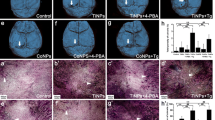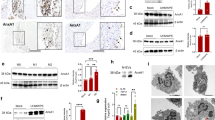Abstract
Aseptic loosening is the major cause of total joint replacement failure. Substance P (SP) is a neurotransmitter richly distributed in sensory nerve fibers, bone, and bone-related tissue. The purpose of this study was to investigate the potential impact of SP on bone metabolism in polyethylene particle-induced osteolysis. We utilized the murine calvarial osteolysis model based on ultrahigh molecular weight polyethylene (UHMWPE) particles in 14 wild-type mice (C57BL/J6) and 14 SP-deficient mice. Group 1 (C57BL/J 6) and group 3 (SP-knockout) received sham surgery, and group 2 (C57BL/J6) and group 4 (SP-knockout) were treated with polyethylene particles. Analytical methods included three-dimensional micro-computed tomographic (micro-CT) analysis and histomorphometry. Bone resorption was measured within the midline suture. The number of osteoclasts was determined by counting the tartrate-resistant acid phosphatase-positive cells. UHMWPE-particle treated SP-deficient mice showed significantly reduced osteolysis compared to wild-type mice, as confirmed by histomorphometry (P < 0.001) and micro-CT (P = 0.035). Osteoclast numbers were significantly reduced in groups 3 and 4 compared to groups 1 and 2 (P < 0.001). Unexpectedly, SP-deficient mice (group 3) showed a significantly increased absolute bone mass compared to wild-type mice (group 1) (P = 0.02). The findings of our murine calvaria model lead to the assumption that SP is a promoter in particle-induced osteolysis. The pathophysiology of aseptic loosening is complex, and neuropeptides are not solely responsible for the progress of implant loosening; however, we conclude that there could be coherence between neurotransmitters and particle-induced osteolysis in patients with aseptic loosening.






Similar content being viewed by others
References
Silva MJ, Sandell LJ (2002) What’s new in orthopaedic research. J Bone Joint Surg Am 84:1490–1496
Hokfelt T, Broberger C, Xu ZQ, Sergeyev V, Ubink R, Diez M (2000) Neuropeptides: an overview. Neuropharmacology 39:1337–1356
Pennefather JN, Lecci A, Candenas ML, Patak E, Pinto FM, Maggi CA (2004) Tachykinins and tachykinin receptors: a growing family. Life Sci 74:1445–1463
Brimijoin S, Lundberg JM, Brodin E, Hokfelt T, Nilsson G (1980) Axonal transport of substance P in the vagus and sciatic nerves of the guinea pig. Brain Res 191:443–447
Brodin E, Gazelius B, Olgart L, Nilsson G (1981) Tissue concentration and release of substance P-like immunoreactivity in the dental pulp. Acta Physiol Scand 111:141–149
Lembeck F, Holzer P (1979) Substance P as neurogenic mediator of antidromic vasodilation and neurogenic plasma extravasation. Arch Pharmacol 310:175–183
Pelletier, Angonin R, Regnard J, Fellmann D, Charbord P (2000) Human bone marrow angiogenesis: in vitro modulation by substance P and neurokinin A. Br J Haematol 119:1083–1089
Hill EL, Elde R (1991) Distribution of CGRP-, VIP-, DbH-, SP-, and NPY-immunoreactive nerves in the periosteum of the rat. Cell Tissue Res 264:469–480
Bjurholm A, Kreicbergs A, Brodin E, Scultzberg M (1991) Substance P and CGRP immunoreactive nerves in bone. Peptides 9:165–171
Hukkanen M, Konttinen YT, Rees RG, Santavirta S, Terenghi G, Polak JM (1992) Distribution of nerve endings and sensory neuropeptides in rat synovium, meniscus and bone. Int J Tissue React 14:1–10
Wojtyys EM, Beaman DN, Glover RA, Janda D (1990) Innervation of the human knee joint by substance-P fibers. Arthroscopy 6:453–459
Hanesch U, Heppelmann B, Schmidt RF (1991) Substance P- and calcitonin gene-related-peptide immunoreactivity in primary afferent neurons of the cat`s knee joint. Neuroscience 45:185–193
Kido MA, Kiyoshima T, Kondo T, Ayasaka N, Moroi R, Terada Y, Tanaka T (1993) Distribution of substance P and calcitonin gene related peptide-like immunoreactive nerve fibers in the rat temporomandibular joint. J Dent Res 72:592–598
Nagata E, Kondo T, Kiyoshima T, Nakata M, Tanaka T (1994) Immunohistochemical evidence for the presence of nerve fibers with substance P- or calcitonin gene-related peptide-like immunoreactivity in the proliferating epithelium in the developing teeth of rat. Arch Oral Biol 39:197–203
Marshall KW, Chiu B, Inman RD (1990) Substance P and arthritis: analysis of plasma and synovial fluid levels. Arhrtitis Rheum 33:87–90
Myers SL, Brandt KD, Ehlich JW, Braunstein EM, Shelbourne KD, Heck DA, Kalasinski LA (1990) Synovial inflammation in patients with early osteoarthritis of the knee. J Rheumatol 17:1662–1669
Togari A, Arai M, Mizutani S, Koshihara Y, Nagatsu T (1997) Expression of mRNA for neuropeptide receptors and beta adrenergic receptors in human osteoblasts and human osteogenic sarcoma cells. Neurosci Lett 233:125–128
Goto T, Yamaza T, Kido MA, Tanaka T (1998) Light and electronmicroscopic study of the distribution of axons containing substance P and localization of neurokinin-1-receptor in bone. Cell Tissue Res 293:87–93
Goto T, Yamaza T, Kido MA, Tanaka T (1992) Immuno-cytochemical localization of cathepsin D in the rat osteoclasts. Histochemistry 97:13–18
Adamus MA, Dabrowski ZJ (2001) Effect of the neuropeptide substance P on the rat bone marrow-derived osteogenic cells in vitro. Cell Biochem 81:499–506
Ahmed M, Bergstrom J, Lundblad H, Gillespie WJ, Kreiebergs A (1998) Sensory nerves in the interface membrane of aseptic loose hip prosthesis. J Bone Joint Surg Br 80:151–155
Saxler G, Löer F, Skumavc M, Pförtner J, Hanesch U (2006) Localization of SP- and CGRP-immunopositive nerve fibers in the hip joint of patients with painful osteoarthritis and of patients with painless failed total hip arthroplasties. Eur J Pain 11(1):67–74
von Knoch M, Sprecher C, Barden B, Saxler G, Loer F, Wimmer M (2004) Size and shape of commercially available polyethylene particles for in-vitro and in-vivo-experiments. Z Orthop Ihre Grenzgeb 142:366–370
von Knoch F, Goldring S, Cho D, Rubash H, Shanbag A (2005) The role of lipopolysaccharides (LPS) in particle induced osteolysis. In: Shanbag AS, Rubash HE, Jacobs JJ (eds), Joint Replacement and Bone Resorption: Pathology, Biomaterials and Clinical Practice. Marcel Dekker, New York, pp 413–428
von Knoch M, Wedemeyer C, Pingsmann A, von Knoch F, Hilken G, Sprecher C, Henschke F, Barden B, Löer F (2005) The decrease of particle-induced osteolysis after a single dose of bisphosphonate. Biomaterials 26:1803–1808
Schwarz EM, Lu AP, Goater JJ, Benz EB, Kollias G, Rosier RN, Puzas JE, O’Keefe RJ (2000) Tumor necrosis factor-alpha/nuclear transcription factor-kappaB signaling in periprosthetic osteolysis. J Orthop Res 18:472–480
Liu CC, Sherrad DJ, Maloney NA, Howard GA (1987) Reactivation of inhibited bone acid phosphatase and its significance in bone histomorphometry. J Histochem Cytochem 35:1355–1363
Parfitt AM, Drezner MK, Glorieux FH, Kanis JA, Malluche H, Meunier PJ, Ott SM, Recker RR (1987) Bone histomorphometry: standardization of nomenclature, symbols, and units. Report of the ASBMR Histomorphometry Nomenclature Committee. J Bone Miner Res 2:595–610
Foreman JC, Jordan CC, Piotrowski W (1982) Interaction of neurotensin with the substance P receptor mediating histamine release from rat mast cells and the flare in human skin. Br J Pharmacol 77:531–539
Solovieva SA, Ceponis A, Konttinen YT Takagi M, Suda A, Eklund KK, Sorsa T, Santavirta S (1996) Mast cells in loosening of totally replaced hips. Clin Orthop 322:158–165
Goto T, Yamaza T, Kido MA, Tanaka T (2001) Substance P activates osteoclast formation and osteoclastic bone resorption through the neurokinin-1-receptor. Acta Histochem Cytochem 34:31–38
Sherman BE, Chole RA (1995) A mechanism for sympathectomy induced bone resorption in the middle ear. Otolaryngol Head Neck Surg 113:569–581
Mori T, Ogata T, Okumura H, Shibata T, Nakamura Y, Kataoka K (1999) Substance P regulates the function of rabbit cultured osteoclast, increase of intracellular free calcium concentration and enhanced bone resorption. Biochem Biophys Res Commun 262:418–422
Sun YM, Luo SJ, Zhao YH (2006) Substance P regulates function of osteoclasts via neurokinin-1 receptor. Hua Xi Kou Quiang Yi Xue Za Zhi 24:60–62
Goto T, Tanaka T (2002) Tachykinins and tachykinin receptors in bone. Microsc Res Tech 58:91–97
Harris WH (2001) Wear and periprosthetic osteolysis. Clin Orthop 392:66–70
Willert HG, Bertram H, Buchhorn GH (1990) Osteolysis in alloarthroplasty of the hip. The role of ultra-high molecular weight polyethylene wear particles. Clin Orthop 258:95–107
Saxler G, Löer F, von Knoch M, von Knoch F, Hanesch U (2005) Localization of the neurokinin 1 receptor in hip joints of patients with painful osteoarthritis. Z Orthop 143:424–430
Barden B, Huttegger C (1999) Failure mechanisms in total hip and knee arthroplasty: a morphologic and radiologic study. Materialwiss. Werkstofftech. 30:746–754
Levine JD, Clark R, Devor M, Helms C, Moskowitz MA, Basbaum AI (1984) Intraneuronal substance P contributes to the severity of experimental arthritis. Science 226:547–549
Lam FY, Ferrell WR (1989) Inhibition of carrageenan induced inflammation in the rat knee joint by substance P antagonist. Ann Rheum Dis 48:928–932
Acknowledgments
The study was supported by Biomaterialien/Ministerium für Forschung und Wissenschaft and IFORES/University of Duisburg-Essen. The authors thank Kaye Schreyer and Bettina Drawe for editorial assistance with the manuscript, Sylvia Marks for technical assistance during histological and immunohistochemical processing of the specimens, and Prof. Iliakis for advice regarding histomorphometry and microscopy.
Author information
Authors and Affiliations
Corresponding author
Rights and permissions
About this article
Cite this article
Wedemeyer, C., Neuerburg, C., Pfeiffer, A. et al. Polyethylene Particle-Induced Bone Resorption in Substance P-Deficient Mice. Calcif Tissue Int 80, 268–274 (2007). https://doi.org/10.1007/s00223-007-9005-5
Received:
Accepted:
Published:
Issue Date:
DOI: https://doi.org/10.1007/s00223-007-9005-5




